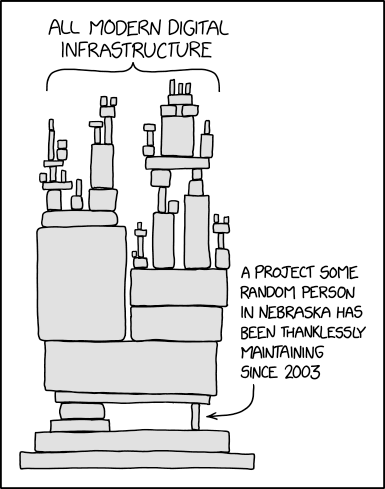The thing is that Electron apps don’t even look good compared to native apps. They’re slow and janky and, once you’ve seen a few of them, your impression is “the company didn’t care enough to build a native app”. In that sense, an Electron webpage in an app has the same connotations as AI artwork on a Substack essay: it looks slick if you’ve never seen one before, but cheap and shoddy if you know what it is.
I’m still convinced Electron only exists because there’s a huge surplus of mediocre web devs.
Electron solves hardly any problem that QT, GTK or all those other UI frameworks didn’t already solve 20 years ago. But for QT you need at least a few developers with passing knowledge of something other than js and css. And those guys are expensive.
OR, it is a huge conspiracy by Micron et al to increase demand for memory modules.
If you’re talking about an app that exist solely as Electron, then you might be right. But the primary benefit of Electron is that you can distribute your already existing webapp as a downloadable app, which reduces the amount of maintenance significantly.
Also, when it comes to UI diversity and customization, nothing beats HTML+CSS.And as you mentioned, there’s a looot of webdevs. Electron empowers those people to easily create applications. Which they did, they created many useful apps. An application that isn’t perfect resource usage-wise is often much better than no application at all.
Think of Minecraft. Java is arguably the worst language to use for a chunk-based 3D game. But it’s still better than no Minecraft at all.
Writing the same app in Javascript for a DOM browser is quicker and easier than writing it in a native GUI toolkit, as you don’t need to think about life cycles or memory management as much. Of course, nothing comes for free, so the cost is borne by the userbase needing more RAM and faster CPUs to get the same work done. Which is philosophically in the same tradition of offloading negative externalities as dumping toxic waste in rivers.
I mean “didn’t care enough” == pay an entire separate dev team to develop for potentially each OS (at least windows probably) in languages unfamiliar to the web team. Then separately maintain that desktop app in perpetuity while the backend changes and drifts. This all for a vanishingly small subset of the userbase that could have used the website with identical functionality. It’s a similar issue with mobile apps.
I fully see the appeal of electron apps even if it’s not perfectly native feeling. I mean vscode is pretty universally liked n that’s electron. Also, it being a web app is a huge boon for anyone needing a code editor in browser.
Perhaps frameworks like Tauri will supplant electron soon enough for better performance and native feel.
The good electron apps are the ones you don’t realise are using electron.

Tangentially related, but I recently stumbled upon this GitHub repository and seeing this same xkcd in their README had me giggling for like 5 minutes
What’s this building? I suspect this might be a crime against architecture as a field.
It really isn’t.
It’s the Antwerp Port Authority in Antwerp, Belgium. Designed by Zaha Hadid. Pretty cool.>!!<
https://en.m.wikipedia.org/wiki/Port_Authority_Building_(Antwerp)
I saw several such hybrid old/new building combinations in Flemish cities. And they usually manage to pull it off.
Another example I liked is the STAM, the Ghent city museum. They also host a nice yearly jazz festival in the courtyard of that one.
I think there’s a bias in the US against this sort of thing that doesn’t exist (or not to the same extent) in Europe due to the age of the cities/buildings.
In the US, a building from the 1700s is a historic artifact to be cherished, while in parts of Europe a building from the 1500s is just the local pub.
So, the US is often hesitant to modify these old buildings, but Europe seems to have more of a perspective of “it’s a building, not a museum, let’s give it new life by modifying it.”
This is just from the perspective of me, from the US — and I think these old/new buildings are really neat!
Huh, thanks for that perspective, I (US native) was firmly in the “how could they do this?!” camp, but you’re right! When old ass buildings are all over the place it’s probably much more pressing to figure out how to allow ongoing development and construction, vs. how to preserve the aesthetic of yet another centuries-old brick structure.
Edit to add: ugh I still can’t get over how ugly and deliberately discordant it looks, reasonable takes be damned!
How do the floors in the upper structure handle the sloping incline of the geometric shape? Is there just a lot of closed off volumetric slivers between the planes of the floor and ceiling and shell, or is there only one or two floors, with the upper floor having a larger rising canopy?
Another similar building is the Bundeswehr Military History Museum in Dresden, Germany
https://en.m.wikipedia.org/wiki/Bundeswehr_Military_History_Museum
All these “slam a triangle on top of an old building” things are fkn ugly though XD
like, modern, nice architecture why not.
RIP Het Steen though, they really did that building dirty
Fuuuuuuck electron
I still can’t fathom why electron needs to exist when PWA is a thing. Like, almost every app is just plain better running in a normal web browser instead of electron. Webapps never need to be updated manually, electron apps do (e.g. discord). Webapps are sandboxed inside the browser, electron has you running some rando developer’s code natively. With electron, you have to trust the developers of every app to keep the electron version up-to-date to avoid critical bugs (e.g. libwebp). With webapps, if your browser is patched, then every webapp is safe. Electron also suffers from random bugs and regressions that aren’t an issue in most web browsers.
TUI FTW
Hey I been searching for a good GTK based code editor. Flatpaks or native ones. Currently using Codium Flatpak.
QtCrGTK? Why?It’s been a hot minute, since I’ve been to the GTK side of town, but I’m aware of Geany and GNOME Builder (I believe, the latter is focused on developing GNOME apps, but not sure to what degree).
Well, and I guess, there’s also gVim and Emacs, if you’re into very keyboard-driven editors…
GNOME Builder seems cool, though, have only tested it out
It’s electron based and not gtk based
I know, I wanted to try a ground up GTK one.
Personally, I like vim. I do miss the mini map to speed up navigating through code, but I don’t think I’ve ever seen a random crash or have it inadvertently fill up my home dir because I’ve had it open for too long.
Tauri gang rise up!
Native GUIs are better.












